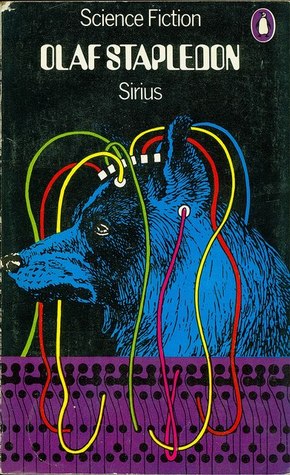 Title: Sirius
Title: Sirius
Author: Olaf Stapledon
Date of First Publication: 1944
Place of Publication: Secker & Warburg, London
Type: Novel
Characters: No Character
Themes: POSTHUMAN/LAST MAN; QUEER FRANKENSTEIN; RACE/POLITICS; SYMPATHETIC MONSTER
Critical Summary: In Sirius, a novel published over one hundred years after Mary Shelley’s Frankenstein, Olaf Stapledon depicts the life of a creature similar to Victor Frankenstein’s, but in the form of a domestic dog bred for intelligence. This animal, Sirius, is raised alongside his creator’s daughter Plaxy, and the two create a special bond throughout their growth from childhood into adult life. Alongside each other, they learn to read and write, and although Plaxy adapts to learning things more easily than Sirius, his communication skills and strong desire for knowledge helps him to maintain an almost even level of intellect with his human companion. Various other difficulties are demonstrated through the depiction of Sirius and Plaxy’s progressions, including the two’s romantic and sexual pursuits, in which neither of them urgently incline to seek for themselves — although, fully aware of their biological and societal expectation for mates. Thomas and Elizabeth Trelone, the creators and caretakers of both Sirius and Plaxy, decide that in order for both to develop properly, time apart in environments that suit their differing needs would be necessary. Consequently, Plaxy departs to college and Sirius finds his new calling in joining Thomas’ less superior super dog creations in farming and sheep herding. Sirius begins to struggle with his animalistic instincts, which result in violence against other animals and eventually humans. The super-canine also battles with more human concerns involving issues of class, race, and religion as he spends time with Mr. Trelone in Cambridge, being tested and examined. As World War II begins to occur within the novel, Mr. and Mrs. Trelone both die, leaving Sirius and Plaxy alone together, until Sirius’ concerning violent phases begin to become too frequent and severe, eventually leading to a battle which leads to serious injury and death.
Sirius, as he becomes increasingly exposed to the world, develops and expresses thoughts, questions, and opinions which are often of the sublime nature. These thoughts concern Sirius’ difficulty in distinguishing himself as either human or dog. With the ability to comprehend topics which are sometimes even incomprehensible to actual humans, the dog finds alienation in receiving different treatment from his two-legged counterparts. Humanity’s effects on the world are delivered through Sirius’ explanation, often combined with interpretation, and demonstrate posthuman themes within the novel. Sirius, being of a different species, examines and interprets the differences in class and the conflicting treatment that those classes receive, especially during wartime. Sirius and Plaxy have discussions that revolve around racial and political themes and demonstrate surprisingly opposing views. Although Sirius receives a great deal more affection than Frankenstein’s monster, the dog still receives alienation from the outside world—despite his brilliant intellect and mostly kind nature.
Themes of the sympathetic monster, and specifically “The Shadow,” are shown through the almost spiritual bond between Plaxy and Sirius who, although are very different, both describe their connection to be of the soul. This strange relationship between the girl and the dog is oddly described at times as romantic, and the two receive massive ridicule from society, demonstrating the theme involving queer Frankenstein. In both Stapledon and Shelley’s novels, the human condition is demonstrated by placing a seemingly nonhuman being into a context in which certain things are needed to survive and succeed as a member of society. Both Frankenstein’s monster and Sirius find the greatest difficulty in having been created and placed into a world in which they cannot find true equal comradeship or properly involve themselves and make use of the skills in which their creators had decided to give them.
Administrative Notes: Payton Davis, CSUF; Alexandra Hollinshead (editing)
